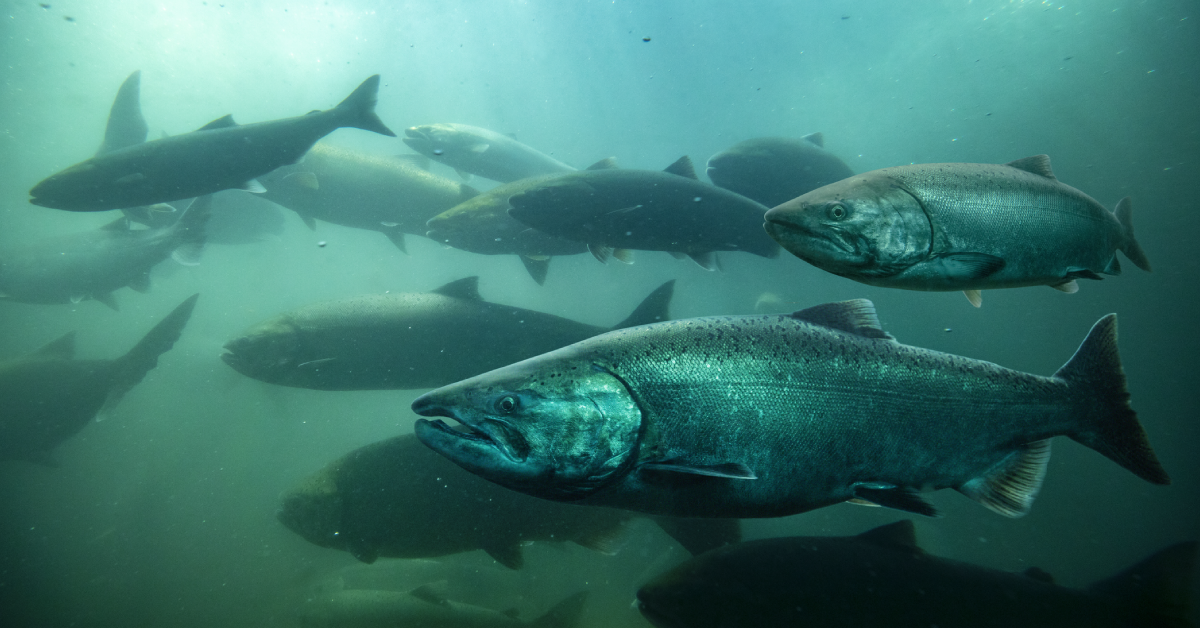Help protect salmon by responsibly storing and disposing of hazardous materials

This salmon “seeson” you can do your part to protect salmon health by properly storing and disposing of your hazardous waste.
Salmon play a vital role in our local food chain and contribute to the health of Puget Sound. According to a report from the Washington Department of Fish & Wildlife, an estimated 138 species of wildlife, from whales to insects, depend on salmon for their food. Additionally, salmon significantly contribute to Washington's economy with the salmon harvest worth close to $14 million annually, according to data from the Governor’s Salmon Recovery Office.
By doing our part to protect salmon health, we are supporting a critical piece of the environment, economy, and culture of the Pacific Northwest.
Pollution is a threat to salmon survival
Pollution from hazardous waste is a significant threat to the health of salmon populations. Contaminants from automotive fluids, yard supplies, cleaners, and other hazardous materials can seep into our waterways when hazardous materials aren’t used, stored, or disposed of properly. This leads to unsafe water quality, which can make it difficult for salmon to navigate, reproduce, avoid predators, and survive.
Types of pollutants impacting salmon:
- Pesticides and herbicides: Chemicals used on gardens and lawns can wash into streams and rivers. Even small amounts of these chemicals can be toxic to fish.
- Motor oil and automotive fluids: Roadways and parking lots accumulate contaminants from automotive fluids, oil, grease, and vehicle exhaust. When it rains, these pollutants then flow into waterways.
- Heavy metals: Metals such as copper, lead, and zinc in stormwater runoff are a significant threat to salmon health.
- Flame retardants: PBDEs (polybrominated diphenyl ethers) are a group of flame retardants used in electronics, furniture, plastics, and children’s toys. These too represent a significant source of toxic exposure for salmon.
The impacts of pollutants on salmon are serious, and include:
- Impaired reproduction: Chemicals can disrupt the hormonal systems of fish, affecting their ability to reproduce and survive.
- Immune system suppression: Pesticides and automotive fluids can suppress the immune systems of salmon, making them more vulnerable to pathogens and disease.
- Nervous system impacts: Certain heavy metals and other toxic products have been shown to impact salmon nervous systems, disrupting their feeding and impacting their ability to avoid predators.
- Habitat degradation: Polluted waters can lead to the loss of critical habitat, such as spawning grounds, making it harder for salmon to thrive.
Safer choices for hazardous materials
As residents of King County, we can take steps to protect our salmon and waterways by making smarter decisions regarding hazardous waste management.
Here are some practical tips:
- Educate yourself: Understand what materials are considered hazardous and how to dispose of them properly. Common household items like cleaning products, paints, and batteries can pose risks if not disposed of correctly.
- Choose non-toxic alternatives: A great way to avoid hazardous waste is to choose safer, more environmentally-friendly products. Opting for non-toxic household products and practicing natural yard care are two steps you can take to limit the risk of toxic chemicals entering our waterways.
- Store hazardous products responsibly: Store your hazardous materials responsibly by keeping products in original containers (ensure they are sealed & undamaged), away from children and pets, and on shelves, not the floor. This is especially important during storm season in the Pacific Northwest.
- Safely dispose of hazardous waste: The Hazardous Waste Management Program in King County offers multiple hazardous waste disposal sites, including locations in North Seattle, South Seattle, Factoria, and Auburn. Dropping off your hazardous waste at these locations ensures proper handling and prevents contamination of local waterways.
The health of our salmon populations is linked to the choices we make regarding hazardous product purchase and disposal. By making informed decisions and embracing safer alternatives, we can steward the protection of these essential fish and the ecosystems they inhabit.
We all share the responsibility of safeguarding our environment for future generations. Together, let’s commit to protecting our waterways, wildlife, and the natural beauty that defines our region.

 Translate
Translate